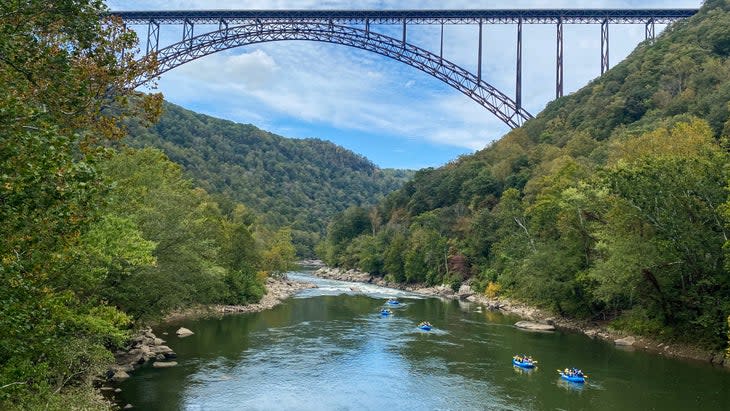New River Gorge National Park and Preserve Is a Wild, Wonderful Adventure
This article originally appeared on Outside
63 Parks Traveler started with a simple goal: to visit every U.S. national park. Avid backpacker and public-lands nerd Emily Pennington saved up, built out a tiny van to travel and live in, and hit the road, practicing COVID-19 best safety protocols along the way. The parks as we know them are rapidly changing, and she wanted to see them before it's too late. New River Gorge is her 62nd park visit.
"I'm gonna call you Han, 'cause today you're riding solo."
My rafting guide, Matt Zickafoose, was everything I'd dreamed of when I signed up to shoot the legendary Class V whitewater of the Upper Gauley. A true-blue Appalachian river rat who'd grown up in West Virginia, Zickafoose, otherwise known as Foose, was unmistakably badass. From his wild, sun-stained blond hair to his frizzy pirate mustache, I was certain when I met him that this was the dude who was going to get me down the river in one piece.
Although not technically inside the national park proper, the Gauley flows into New River Gorge's namesake waterway, which is one of the most famous whitewater hubs in the world. The New, as it's affectionately called, can be rafted year-round, while the Gauley rears its powerful head in autumn; starting the weekend after Labor Day, a controlled torrent of water measuring nearly 2,800 cubic feet per second is released from the Summersville Dam, creating the perfect conditions to run heart-thumping, adrenaline-jolting, technical rapids. The highly anticipated event, commonly referred to as Gauley Season, draws more than 60,000 people annually.

It was my third day in the area, and while I'd enjoyed the breathtaking fall foliage and locals' otherworldly kindness, the thought of enduring butt-clenching drop after drop of Class IV and V whitewater made my chest tight and my palms clammy before I even set foot in the raft.
With minimal instruction on how to navigate the river's more extreme challenges, each person in my group of seven grabbed a paddle and plopped down in our inflatable polyvinyl vessel. The mood was tense as Foose cracked jokes and barked orders meant to help us survive our first big rapid of the day, the sardonically named Insignificant.
We paddled hard on the right, then leaned in to absorb the impact of a massive thwap of water that engulfed our raft, soaking me through to the bone. "Not bad," Foose said as he steered the bucking vessel toward calmer waters. "Now you've only got four more class fives to go!"
Things continued in the same raucous manner-our guide shouting a stern series of orders to get us between boulders safely, then making wisecracks about local history and why the nearby levee wasn't named the Gauley Dam (hint: try saying that out loud). When we finally made it back to the take-out point, six hours later, Foose tossed me a chilly PBR, which I drank heartily as though it was manna from heaven.
My mind was scrambled from being sloshed around the unrelenting waters of the Gauley all day, yet I couldn't help but break into a dazed smile behind the aluminum lip of my beer can. In less than 72 hours, I'd hiked to forested overlooks, crimped my way up Nuttall sandstone, and soaked myself from head to toe in the river. West Virginia had certainly earned its state slogan--the place was truly Wild and Wonderful.
https://www.instagram.com/p/CVI2z_JFtcx/
63 Parks Traveler New River Gorge Info
Size: 72,808 acres (national park and preserve)
Location: Central West Virginia, near Charleston
Created In: 1978 (national river), 2020 (national park)
Best For: Whitewater rafting, rock climbing, hiking, fishing, birding, primitive camping
When to Go: Fall (30 to 71 degrees) has the perfect moderate temperatures for hiking and rock climbing, not to mention the return of the heralded Gauley Season (and eager crowds to match on those weekends). Spring (27 to 70 degrees) is also a fantastic time to enjoy pleasant hiking and climbing, while summer (55 to 77 degrees) is regarded as hot and humid--great weather to enjoy swimming, rafting, and other watersports. Winter (19 to 42 degrees) is the season to escape the hordes, if you don't mind a chill.
Where to Stay: The only official camping in New River Gorge National Park and Preserve is a series of no-fee primitive sites near the water, each accessed by a maintained gravel road. If you're looking for creature comforts to spare, Adventures on the Gorge hosts a slew of well-appointed cabins and glamping tents; amenities include restrooms, hot showers, and an on-site restaurant, Smokey's, which overlooks the gorge.
Mini Adventure: From the town of Fayetteville, at the northern end of the park, hike the three miles out to Long Point; the trek is relatively flat and shaded, but the payoff is huge, with awesome vistas of the New River and its famous steel arch bridge. Afterward, for a different perspective of the overpass, take a scenic drive down Fayette Station Road, with its hairpin turns and canopy of beeches and hemlocks. Pro tip: Plan your drive for the late afternoon so you can watch the day's rafters float by beneath the old Fayette Station bridge.
Mega Adventure: Go on an all-day rafting trip. The national park and its surrounding areas are something of a mecca for whitewater devotees, with challenging, smile-inducing options available to adults of all experience levels and children over six. The Upper New River is an ideal starting place for beginners and families with youngsters, while the Lower New River offers more intermediate rafting for those unafraid of the splash zone. In fall, the roaring Gauley River begins its brief but rowdy season, with bucket-list-worthy rapids ready for the brave.
For exclusive access to all of our fitness, gear, adventure, and travel stories, plus discounts on trips, events, and gear, sign up for Outside+ today.
